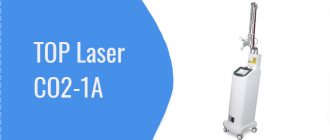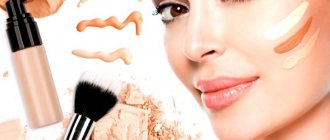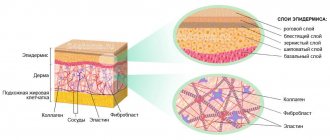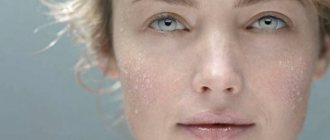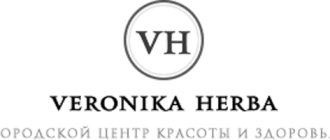A scar is the formation of connective tissue in the area of wound healing. Scars, including those that remain after surgery, do not look aesthetically pleasing, and a person may feel discomfort due to the fact that there are scars on his body. However, with the help of modern medicine, this cosmetic defect can be eliminated.
Laser is used to remove postoperative scars. They are removed using laser resurfacing. The advantages of scar resurfacing include a minimal risk of complications. The maximum effect is achieved from this procedure.
What is a scar? What types of scars are there?
The following types of scars are distinguished:
Normotrophic scarIt does not rise above the surface of the skin, is practically invisible, and is formed during the normal healing ability of the tissue. | |
Atrophic scarFlesh or whitish in color, slightly retracted into the skin. Usually occurs with minor damage. A type of atrophic scars are post-acne scars (scars after acne). | |
HypertrophicRough, dense, rises above the surface of the skin. As a rule, it occurs with deep damage to the skin (burns, lacerations). They are often located in the neck, joints and other moving areas prone to permanent injury. | |
Keloid scarIt is a pathological growth of scar tissue, far beyond the boundaries of the primary scar, bluish or bright pink in color, dense and lumpy to the touch. Often accompanied by pain and itching. The exact cause of keloid has not been established. An important role is played by hereditary predisposition to keloidosis and the location of the injury (ears, sternum and pubic area, etc.). |
Neodymium exposure type
You can remove scars from laser cuts on your arm or other parts of the body using a neodymium device. The device is used for fractional photothermolysis and is the most gentle. But to completely remove scar tissue, it is necessary to undergo a larger number of sessions, compared to other types of laser therapy.
Under the influence of the device, the vascular tissue located in the scar area undergoes partial coagulation. As a result, collagen fibers begin to break down. The production of new collagen and the formation of fibroblasts begin, which help the scar to resolve on its own.
How does laser work in scar treatment?
Laser scar treatment is the only procedure that can reduce the depth of scars and eliminate them permanently.
The essence of laser scar treatment is to remove the top layers of skin along with scar tissue. At the same time, restoration processes in the treated areas are enhanced, new young collagen and elastin are synthesized, which leads to the formation of a normal structure of the dermis.
It should be noted that red fresh scars and keloid scars are not always indications for scar resurfacing. As a rule, you should wait until the inflammation subsides and the formation of scar tissue stops before performing the laser scar removal procedure. On average, this process takes up to six months.
Duration of scar formation
Laser scar resurfacing can be done after natural healing of the wound: this period lasts from 3-6 months. Treatment should begin with special creams and gels, and after six months it is allowed to switch to hardware therapy. The recovery process becomes more difficult after one year.
In practice, atrophic and keloid changes are the most difficult to cope with: in the latter case, surgical removal of excess tissue may be required.
How to treat fresh scars?
To speed up healing and prevent the formation of rough scar tissue, conservative treatment of fresh scars and stretch marks should be carried out. This will allow you to get a neat, tight scar, sometimes almost invisible, which will significantly reduce the number of laser resurfacings. Excellent results are obtained by plasma therapy (plasmolifting), placentotherapy, mesotherapy with anti-inflammatory and defibrosing components in combination with methyl agents for the treatment of scar tissue.
Patient age
Removing marks after injuries in adulthood is much more difficult than for young people. This is due to the fact that the elasticity of the skin gradually decreases. Therefore, it will take a lot of effort to build up a healthy appearance and provoke the growth of fibroblasts using a laser. It will take a long time to cope with old scars.
For the purpose of blepharoplasty, laser resurfacing is performed at any age. They do it to rejuvenate, reduce skin sagging, and reduce wrinkles. The procedure takes place without surgical intervention, and this makes it safe. The main thing is to find a specialized specialist with high-quality equipment.
How is the laser scar resurfacing procedure performed?
Removing scars is most often a painless procedure. However, in some cases there is increased sensitivity of the skin to the laser. In such a situation, local anesthesia with an anesthetic cream is used. During the day, slight swelling and redness of the treated area may persist, and then small crusts will form, which will go away within a week.
After the procedure, you must avoid damaging the scar area for three days. This area should be protected from direct sunlight. To do this, use sunscreen. The cream is used for at least six weeks after the laser resurfacing procedure. The result of the procedure is long-lasting.
| Before | After |
When is the best time to start laser treatment?
Laser scar resurfacing can be done on any part of the body: face, décolleté, neck, legs, arms, abdomen, back.
The session takes place only after the site has been examined. To do this, palpation and exchange of information between the patient and the cosmetologist are carried out. The specialist must know the cause of the skin pathology, evaluate the client for possible contraindications, and only then prescribe the procedure. The size and depth of the laser beam, as well as the vibration frequency, are selected separately. As a result, after proper hardware treatment, scar tissue is destroyed and new elastic, smooth skin is formed.
If you contact a professional cosmetologist, you can remove the scar with laser within one year.
How many treatments are needed to remove scars?
The number of procedures depends on the age, type and size of the scar. Normotrophic scars are most favorable for correction. Atrophic scars (for example, post-acne scars) can completely disappear either after one procedure or after a series of laser resurfacing, which is determined by the depth of the scars. Correction of large hypertrophic scars is complex and requires multiple resurfacings. The most difficult to correct are keloid scars; the question of the advisability of their resurfacing is decided individually, and, as a rule, is accompanied by drug therapy. After the first resurfacing, the scar is usually reduced by 20-30%.
Presence of contraindications
The session is scheduled after a conversation with the patient, when the degree of risk is determined. But in most cases, laser scar resurfacing can be done if contraindications are met:
- no pregnancy;
- the infant is not fed;
- blood clotting is not impaired;
- no skin diseases - psoriasis, eczema, vitiligo, dermatitis;
- no diabetes mellitus;
- pressure does not increase.
The procedure is also contraindicated for scleroderma and collagenosis.
What approaches exist to the treatment of post-acne scars?
Marks, scars, acne scars are a very common problem, and many patients are interested in how to get rid of it.
To treat post-acne scars (acne scars), various types of peels are often used. However, compared to laser resurfacing, the patient requires many procedures with a long recovery period.
Hirudotherapy is an indispensable method of treating fresh scars. The enzymes contained in leech saliva have a pronounced absorbable and anti-inflammatory effect. With the help of hirudotherapy, a scar can be significantly reduced in size, transform a hypertrophic scar into a normotrophic one, speed up the healing process and prepare for laser removal of scars.
What are the benefits of laser scar removal?
- The operation is very effective, as it makes it possible to completely remove the formation.
- During the procedure there is no contact with the wound, which means there is no danger of infectious tissue infection
- Scars of different sizes can be removed
- It is possible to provide a targeted effect without affecting healthy tissue
- The operation is bloodless (what is its main difference from surgical removal of a scar)
- Since the effect of the erbium laser is very gentle, there is no hyperpigmentation after the procedure.
- According to patient reviews, there is no serious pain during the operation.
What are acne scars and wrinkles
Wrinkles, as we know, inevitably appear with age. The skin becomes less elastic and stretches. The process of cell renewal slows down. Aggressive exposure to the sun on the epidermis layer (photoaging) accelerates the formation of wrinkles. The use of creams does not solve this problem. The same can be said about acne scars. Moisturizing and nourishing with cosmetics does not eliminate acne scars. They represent a violation of the relief of the skin, and this defect can only be eliminated with the help of laser resurfacing.
When and what effect can be expected
There are several ways to remove a scar with a laser:
- Laser microdermabrasion (peeling, laser resurfacing of scars). Gradual removal of layers of scar connective tissue to stimulate cellular regeneration, collagen production, and fibroblast activity. Performed only in winter or autumn due to the danger of hyperpigmentation under the influence of sunlight. Recovery after the procedure occurs within two months;
- Fractional photothermolysis (microperforation, multipiling, nanoperforation). Performed with pinpoint impulses to eliminate traces of chickenpox, post-acne, acne or stretch marks. After exposure to a fractional beam, the synthesis of elastin and collagen increases. As a result of saturation of the epidermal layer with water, the skin becomes smoother;
- Cauterization of blood vessels in connective tissue. The method is used for pink, purple or red scars.
To lighten a small “fresh” scar, 1-2 procedures are enough. To treat dense, rough scars, a complex of 3-5 sessions will be required. The recommended break between procedures is 3 weeks.
Efficacy and possible complications
You can quickly and effectively remove scars from laser cuts on your arm or other areas of the skin without consequences. Complications from therapy develop extremely rarely. In isolated cases, dermatitis and herpes appeared after the procedure. But this is due to a violation of the treatment rules.
Other possible complications:
- Erythema. May form 2 weeks after treatment. The disorder occurs against the background of high skin sensitivity. Goes away on its own within a few months.
- Formation of scar tissue. Occurs with strong and prolonged exposure to laser.
- Infection. It develops extremely rarely, due to disturbances in the treatment process.
- Pigmentation. May appear in people with very dark or light skin color.
If any negative reactions develop, you should contact your doctor at the clinic for advice.
Facial skin care after laser resurfacing
During rehabilitation, you will need to apply ointments such as equator or Vaseline every day. This helps the skin recover quickly. It must be remembered that the period of complete recovery depends on the depth of penetration of the laser beam and on the individual characteristics of the body.
Since after the procedure the skin receives a slight burn, so you need to wait until it heals. At this time, you should avoid scratching the skin and removing scabs yourself.
Features of the procedure for children
Laser therapy is considered safe and has no age restrictions. However, it is recommended to remove scars after injuries with a laser after 14 years of age: the risks of developing side effects in childhood are much higher.
Newborns or preschool children have more delicate skin, which, as practice shows, can cause various complications to develop. Children of this age are not recommended to resort to radical methods of removing scars and defects unless absolutely necessary. For treatment, a variety of absorbable ointments or gels are used.
